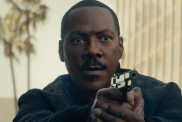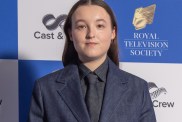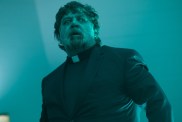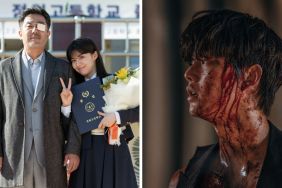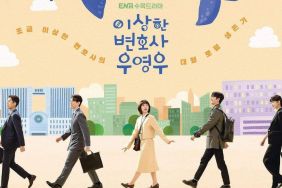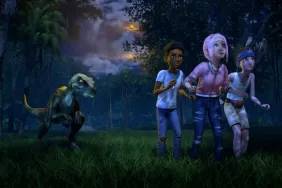
My journey with Jurassic Park has its ups and downs. I was just a shade over 16-years-old when the film hit theaters in 1993 and my interest in the movie was sparked by having read Michael Crichton‘s novel from which it was based. To ask me now, I couldn’t detail the differences versus the book and the film (though this video helps with that) other than to remember the book featured a lot more dinosaurs and was a bit more mature than Steven Spielberg‘s adaptation, from a screenplay co-written by Crichton and David Koepp (Angels & Demons, Spider-Man).
So, that summer in June, myself and three friends ventured into the theater to see dinosaurs come to life and that’s what we got. Perhaps it was my age, perhaps it was having read the books, but I remember being vaguely underwhelmed, though at the same time I remember pretending I had enjoyed it more than I actually had. In fact, I remember going to see it a second time within a week so as to keep up appearances. Why? I couldn’t tell you now, but it seems to have always left a cloud of doubt over the film in my mind. Did I really dislike it that much? Is it actually much better than I remember enjoying it or was my 16-year-old self onto something? Four years ago I re-watched the trilogy on Blu-ray and later Jurassic World tonight and loved damn near every minute.

The casting across the board is spot on with Jeff Goldblum stealing every scene he’s in whether it’s with a one-liner or as he relaxes in a pose reminiscent of George Costanza’s “Timeless Art of Seduction”. The child performers — Joseph Mazzello and Ariana Richards — capture Spielberg’s sense of wonderment while Sam Neill and Laura Dern deliver both wisdom and compassion, not to mention strength and their own sense of childlike wonder, which also contributes to the plot as they must learn to overlook the amazing spectacle John Hammond (the wonderful Richard Attenborough) has created and look at the reality of said creation.
Samuel L. Jackson, Wayne Knight and Bob Peck are not only vital to the film, they deliver some of the best moments in a film filled with great moments. Hell, these three alone deliver some of the most memorable lines including “Hold on to your butts”, “Stick stupid” and “Clever girl”, the latter of which may be the film’s most memorable, which is saying something considering you could make a top ten based on Ian Malcolm’s (Goldblum) dialogue alone.
Where to go next is a toss-up. I’ll move to John Williams‘ score, which I’m not sure there are words to describe its impact. While I was conflicted on my thoughts on the overall film when I first saw it, I was not at all conflicted when it came to the score. I loved it. I owned it. I put the CD on repeat and last night, as the opening credits began to play and bass rumbled, I was immediately transported. Then, as the helicopter flies over the ocean and we get our first look at Isla Nublar it’s as though we are witness to another world even though it’s a world we can recognize as our own. Williams’ score propels that, elevates it to the point hearing it is beyond nostalgia and memory. Synapses begin firing and our brains can’t help but light up with excitement.

Obviously creating a lot of excitement are the film’s visual effects, but I wonder, how many people realize just how much was digital versus how much was practical? The movie runs 127 minutes long and of that approximately 15 minutes feature dinosaur effects and of those 15 minutes only about six were created in the computer. In fact, did you know the moment the raptor is hunting the two children in the kitchen and it gets up on its hind legs and calls to the other raptor that’s actually a man in a raptor suit? For as much as Jurassic Park was an example of how helpful CGI can be in creating an epic feel in a film (watch this video), it also showed the importance of practical effects.
The marriage of digital and practical effects in Jurassic Park was perfect, primarily in that the idea of CGI in a movie was still relatively new so the concepts in the film were still based largely on what would have been done had they been forced to use stop motion and motion blur effects, which was the original plan. In this respect, CG was used to enhance and improve what might have made Jurassic Park look like an updated effects movie, but still not much better than all the original stop motion features that came before it.
So what makes for a perfect marriage of CG and practical? It’s hard to tell as we’ve clearly seen films rely too heavily on digital effects and with Jurassic World we’re going to see a mixture of not only digital and practical effects, but also performance capture, which is essentially the new age of “actors in a raptor suit”. The result will be interesting.
Finally, respect must be paid to Spielberg for what I can only describe as his artistry in the design of a spectacle. Jurassic Park is an excellent example of when Spielberg is hitting all the right notes. He’s got a leaning toward familial aspects and his work can get occasionally sappy, but he never goes overboard here and even if he did it would be balanced out by the fact these characters are in real, unpredictable danger. The movie establishes early and often just what kind of threat the people are facing. No one knows how a dinosaur will behave, not entirely, so as corny as the moment the raptor learns to open a door might seem in a movie where the intelligence of the raptors hadn’t been a priority and the threat hadn’t seemed so real, then it would have seemed corny. But, instead of laughing at the movie at that moment, the audience laughs with unease. It’s an “Oh shit” moment and not too much longer we see their massive claws tapping on the kitchen floor and we think back to Dr. Grant’s mimicking the gutting of the young boy at the beginning of the film. Picture perfect.
A scene-by-scene breakdown and analysis of this film would be incredibly easy and I was so happy returning to it last night, preparing for my IMAX screening of Jurassic World tonight, which does have me a bit concerned. I have my concerns over story, as it seems to merely be doing the same old thing all over again, and I also have my concern over the effects. Spielberg has proven to be a master of these types of films. As I said already, there are only 15 minutes worth of dinosaurs in Jurassic Park and remember Jaws? Yeah, the shark doesn’t fully appear in a shot until 1 hour and 21 minutes into that movie. Will director Colin Trevorrow show the same restraint or will a recent quote (via Vice) from recently retired makeup master Rick Baker prove relevant:
“I have the hardest time going to movies now and caring about stuff. I’m an effects nerd, that’s the kind of stuff that got me into this, and I watch films and I’m like, Why do I not care? Why am I just so bored? That’s one of the downfalls of the CGI stuff. You can do anything. But does it make it better? I don’t necessarily think so.”
I agree and disagree with Baker on this point as I think CG can make things better, but I don’t think it’s looked at as a tool to necessarily make things better as much as it’s looked at to make all things. Jurassic Park features a baby dinosaur cracking out of its shell. It’s a puppet and the actors can interact with it, playing off the goo on its newly “born” body. Would today’s filmmakers opt for an all-CG baby? Would they replace the practical dinosaur used on set with a CG dinosaur in post? Would that make it better? It’s a hard line to know when to cross and when to hold back and filmmakers will probably never know until the project is completed. That’s to say they’re constantly stuck between a rock and a hard place, but with a film like this it almost would seem the old adage of “less is more” applies, at elast if you’re looking to find the same success Spielberg has time and again.
[yt id=”KWsbcBvYqN8″ width=”965″]
